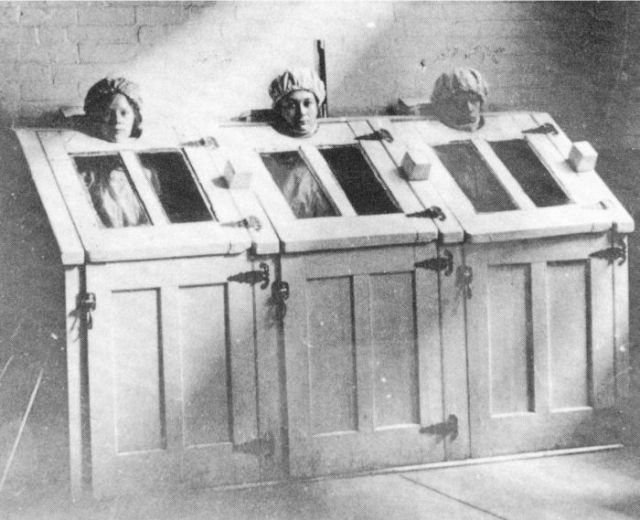Lucky for us, we live in a time where medicine and science have made great strides in the development of effective treatments to diseases that were once fatal. Nowadays, many diseases and disorders are alleviated with pills, injections or ointments. Those that require surgical procedures are carried out with lower risk than ever before.
In the past however, many of the treatments utilized by medical physicians were almost as harmful as the condition they were meant to cure. These procedures were often highly invasive and ineffective and many patients died as a result of them. Methods in the psychiatric field were particularly bizarre and often exhibited a cruel lack of regard for the mentally ill. Many unfortunate patients were left disfigured or had their personalities irreversibly altered as a result of the procedures undergone and the benefits were often nominal or nil. Here are some bizarre treatments that have been employed to treat mental illness in the past.
10. Trephination

Also known as trepanning, trephination was an ancient practice dating way back as early as the Mesolithic era. It was a procedure whereby a hole was bored into the skull of patients suffering from schizophrenia, epileptic seizures or migraines. It was believed that evil spirits thought to be responsible for abnormal behavior and mental disturbances could be released through the cranial opening. The surgery was achieved using augurs and saws and was likely painful due to the absence of modern anesthesia. The removed portion of bone was replaced shortly after but often healed with some distortion in the skull’s shape and contour.
9. Fever Therapy

It sounds counter-intuitive but one doctor found that the best weapon against a malady is another malady. In the late 1800s, fever therapy (also known as pyrotherapy) was all the rage after it successfully alleviated the symptoms of patients suffering from neurosyphilis also known as general paresis of the insane (GPI). The treatment was pioneered by Viennese psychiatrist Julius Wagner-Juaregg who won a Nobel Prize in 1927 for “curing” a patient’s syphilis-caused psychosis by artificially inducing them with fever. The treatment entailed the elevation of the patient’s body temperature by injecting them with malaria-infected blood taken from another person. At that time, blood groups were only recently discovered and little consideration was given to it when transfusing blood between patients. Many doctors began adopting this radical and seemingly effective treatment until Penicillin came along in the mid 1940s. In the 1930s, machines were developed that could reproduce the same thermogenic effects of fever therapy without subjecting patients to undue illness. Alternate forms of pyrotherapy employ the use of hot baths and electric blankets to raise temperature.
8. Rotational Therapy

Before Charles Darwin, there was his grandfather Erasmus Darwin. Erasmus was a physician, scientist and philosopher although he was reputedly not very good at any one of those things. He believed that sleep cured illness and therefore saw spinning around as an effective means of inducing therapeutic sleep. His idea was largely dismissed but was later employed by Dr. Benjamin Rush as a treatment for mental illness. Rush, who was one of the original signatories of the U.S. Declaration of Independence, believed that mental illness was a symptom of brain congestion and he held the notion that spinning around would dislodge brain mucous like a centrifuge and produce mental clarity. Of course, all that spinning just left them dizzy, dazed and confused.
7. Lobotomy

The Lobotomy (also known as leucotomy) has been a controversial procedure from it’s very inception due to the disproportion of benefits and drawbacks. The procedure was pioneered by Portuguese neurologist António Egas Moniz who utilized it in the treatment of various psychoses and problematic behaviors. The procedure was conducted by inserting an ice pick through the eye sockets to scrape away portions of the brain’s pre-frontal cortex to disrupt neuro-circuitry associated with unwanted symptoms. While the operation appeared to improve patient’s symptoms, it also came at the expense of their intellect and personality. Some patients died as a result of the operation either due to post-surgery complications or suicide. Others were left a shell of their former selves with severe mental impairments and somatic disabilities such as loss of bowel control. In spite of this, Moniz’s work earned him a Nobel Prize for Physiology or Medicine in 1949. In the U.S., nearly 19,000 people have been lobotomized before antipsychotic medication supplanted it.
6. Bloodletting and Purging

Although this treatment gained prominence in the Western world during the 1600s, it actually originated in ancient Greek medicine. The prominent Greek physician Claudius Galen regarded an imbalance of the humors as the source of poor health and physical malady. English physician Thomas Willis later used Galen’s work as a basis for his approach to treating mentally ill patients. He argued that “an internal biochemical relationship was responsible for mental disorders. He believed bleeding, purging, and even vomiting could help correct the humor imbalances and aid in healing physical and mental illness. In addition to mental illness, these treatments were also used to treat various other diseases like diabetes, asthma, cancer, cholera, and smallpox.
5. Hydrotherapy

During the early 20th century, water-based methods became popular in treating mental illness. It was favored due to it’s simplicity and effectiveness in treating patients with insomnia and manic depressive symptoms. Patients were subjected to methods such as cold plunges, being sprayed or hosed down with hot and cold water jets or being confined to prolonged baths that lasted from hours to several days interspersed with periodic bathroom breaks. Clinicians observed the therapeutic effects of varying temperatures on the body and it’s nervous system. It was believed that various properties of water could be used stimulate circulation and improve symptoms accompanying certain diseases.
4. Mesmerism

The term “mersmerize” comes from an Austrian physician named Franz Anton Mesmer. Mesmer believed that physical and mental illness were the result of magnetic imbalances in the body. He called these forces “animal magnetism” and was convinced that restoring it’s equilibrium would alleviate health problems. Mesmer administered iron medication to patients and then passed magnets over their body. He found that patients responded positively to his unconventional treatment and later he abandoned using the magnets altogether once he saw that he could achieve the same affects without them. What he did not realize however, was that his patients were only psychologically responding to the power of suggestion and the “belief” that his treatment was working. Mesmer’s methods were dismissed as a quackery by the medical community and he later moved to Paris where he continued to practice his therapy on large groups of people. His work paved the way to the development of hypnotism.
3. Metrazol Shock Therapy

In the 1930s, a pathologist named Ladislas von Meduna observed that patients who experienced epileptic seizures would afterward become calmer. This led him to test and see if the same effect could be achieved in patients suffering from schizophrenia. After experimenting with various drugs such as strychnine and absinthe, the physician eventually found metrazol to be an effective solution. Metrazol stimulated the respiratory and circulatory systems and triggered seizures. Clinical reports indicate that the treatment appeared to improve symptoms in nearly half of patients. However, many also suffered vertebral fractures, myocardial damage and pulmonary tuberculosis as a result of treatment. Researchers later realized the therapy was actually not all that effective and it was barred in 1982 by the FDA. This form of seizure therapy was a precursor to electric shocks and ECT.
2. Tooth Extractions

At the turn of the 20th century, the advancements in medicine generated an enthusiasm that may have led medical professionals to get a bit ahead of themselves. A New Jersey psychiatrist named Henry Cotton developed the idea that mental illnesses of all kinds were the result of untreated infections in other parts of the body. He introduced the practice of “surgical bacteriology” where he proceeded to remove body parts such as teeth, spleens, tonsils, ovaries and other organs believed to harbor infection. Due to the absence of antibiotics, many patients died ironically from post-operative infection. Cotton reported high success rates but it is believed that his results were skewed. In spite of the high fatality outcomes of his operations, he was still largely admired by the public and lauded for his work.
1. Insulin Shock Therapy

Insulin Shock therapy was used extensively throughout the 1940s and 50s as a treatment for Schizophrenia. The practice involved injecting insulin into patients to induce coma. This was done multiple times until symptoms appeared to go into remission. It was first introduced by Manfred Sakel, an Austrian-American psychiatrist who began using the treatment in low sub-coma doses to treat drug addicts and psychopaths. With Schizophrenics, heavier doses were administered 6 days a week over the course of 2 months to 2 years. Dosages were increased gradually up to 100-450 units and clinics that used the treatment employed their own protocols as there were no standardized guidelines in place. Complications caused by treatment included hypoglycemia, convulsions, restlessness, brain damage, obesity and death. By the 1970s, the use of Insulin Shock therapy had fallen out of vogue after it was debunked as ineffective and too dangerous.
sources:
Link: http://www.pbs.org/wgbh/amex/nash/filmmore/ps_ict.html
Link: http://www.inquiriesjournal.com/articles/283/the-history-of-mental-illness-from-skull-drills-to-happy-pills
Link: https://www.ncbi.nlm.nih.gov/pmc/articles/PMC3640229/
Link: https://books.google.com/books?id=9EYuAAAAIAAJ&pg=PA121&lpg=PA121&dq=trephination+bone+replacement&source=bl&ots=Jdy0bA24Dr&sig=62_BijYIBKKQbymZ-UM1134un0w&hl=en&sa=X&ved=0ahUKEwjNqcjX9-fRAhUC4CYKHYGWAEEQ6AEINTAE#v=onepage&q=trephination%20bone%20replacement&f=false
Link: https://www.theatlantic.com/health/archive/2014/10/the-tragic-sadistic-mental-illness-treatment-from-the-knick-is-real/381751/
Link: http://www.fairfieldstatehospital.com/metrazol.html
Link: https://www.lib.uwo.ca/archives/virtualexhibits/londonasylum/hydrotherapy.html
Link: https://psychcentral.com/blog/archives/2011/02/17/the-birth-of-the-mental-asylum/
https://psychcentral.com/blog/archives/2011/05/09/psychologys-history-of-being-mesmerized/
Link: https://psychcentral.com/blog/archives/2011/03/21/the-surprising-history-of-the-lobotomy/
Link: http://www.everydayhealth.com/pictures/worst-mental-health-treatments-history/#03
Link: https://www.improbable.com/airchives/paperair/volume20/v20i3/centrifuging%20mental%20patients.pdf
Link: https://bashny.net/t/en/260586
Link: http://www.cbsnews.com/pictures/19th-and-20th-century-psychiatry-22-rare-photos/21/
Link: http://pediatrics.aappublications.org/content/117/2/e320.full
Want to know your astrology placements? You can generate your astrology chart here with our free birth chart generator tool.
related posts:
- 9 Rare and Interesting Psychological Disorders
- The Evolution of Psychotherapy | Infographic
- The Mental Illness Of Each Myers Briggs Type
- 5 Scientific Facts About the Introvert Brain
- A Twisted Sense of Humor May Be A Sign of Intelligence
- The Intelligence Each MBTI Type Displays
- 6 Signs Of High Intelligence That May Surprise You
- ESTP and ESFP in love: 6 Dynamics of Their Relationship - September 4, 2024
- ISFP and ISTP in love: 5 Dynamics of their Relationship. - August 28, 2024
- ISFJ and ISTJ in love: 5 Essential Dynamics of their Relationship - February 24, 2024





